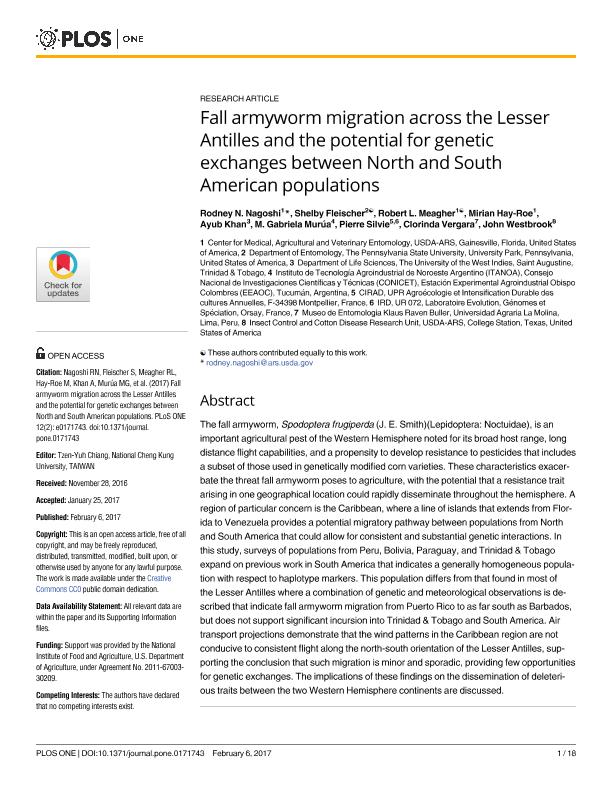Mostrar el registro sencillo del ítem
dc.contributor.author
Rodney N. Nagoshi
dc.contributor.author
Fleischer, Shelby
dc.contributor.author
Meagher, Robert L.
dc.contributor.author
Hay Roe, Mirian
dc.contributor.author
Khan, Ayub
dc.contributor.author
Murúa, María Gabriela

dc.contributor.author
Silvie, Pierre
dc.contributor.author
Vergara, Clorinda
dc.contributor.author
Westbrook, John
dc.date.available
2018-10-25T20:20:22Z
dc.date.issued
2017-02
dc.identifier.citation
Rodney N. Nagoshi; Fleischer, Shelby; Meagher, Robert L.; Hay Roe, Mirian; Khan, Ayub; et al.; Fall armyworm migration across the lesser antilles and the potential for genetic exchanges between north and south American populations; Public Library of Science; Plos One; 12; 2; 2-2017; 1-18
dc.identifier.issn
1932-6203
dc.identifier.uri
http://hdl.handle.net/11336/63109
dc.description.abstract
The fall armyworm, Spodoptera frugiperda (J. E. Smith)(Lepidoptera: Noctuidae), is an important agricultural pest of the Western Hemisphere noted for its broad host range, long distance flight capabilities, and a propensity to develop resistance to pesticides that includes a subset of those used in genetically modified corn varieties. These characteristics exacerbate the threat fall armyworm poses to agriculture, with the potential that a resistance trait arising in one geographical location could rapidly disseminate throughout the hemisphere. A region of particular concern is the Caribbean, where a line of islands that extends from Florida to Venezuela provides a potential migratory pathway between populations from North and South America that could allow for consistent and substantial genetic interactions. In this study, surveys of populations from Peru, Bolivia, Paraguay, and Trinidad & Tobago expand on previous work in South America that indicates a generally homogeneous population with respect to haplotype markers. This population differs from that found in most of the Lesser Antilles where a combination of genetic and meteorological observations is described that indicate fall armyworm migration from Puerto Rico to as far south as Barbados, but does not support significant incursion into Trinidad & Tobago and South America. Air transport projections demonstrate that the wind patterns in the Caribbean region are not conducive to consistent flight along the north-south orientation of the Lesser Antilles, supporting the conclusion that such migration is minor and sporadic, providing few opportunities for genetic exchanges. The implications of these findings on the dissemination of deleterious traits between the two Western Hemisphere continents are discussed.
dc.format
application/pdf
dc.language.iso
eng
dc.publisher
Public Library of Science

dc.rights
info:eu-repo/semantics/openAccess
dc.rights.uri
https://creativecommons.org/licenses/by-nc-sa/2.5/ar/
dc.subject
Spodoptera Frugiperda
dc.subject.classification
Otras Ciencias Biológicas

dc.subject.classification
Ciencias Biológicas

dc.subject.classification
CIENCIAS NATURALES Y EXACTAS

dc.title
Fall armyworm migration across the lesser antilles and the potential for genetic exchanges between north and south American populations
dc.type
info:eu-repo/semantics/article
dc.type
info:ar-repo/semantics/artículo
dc.type
info:eu-repo/semantics/publishedVersion
dc.date.updated
2018-10-23T17:51:56Z
dc.journal.volume
12
dc.journal.number
2
dc.journal.pagination
1-18
dc.journal.pais
Estados Unidos

dc.journal.ciudad
San Francisco
dc.description.fil
Fil: Rodney N. Nagoshi. United States Department Of Agriculture. Center For Medical Agric And Vet Entomology; Estados Unidos
dc.description.fil
Fil: Fleischer, Shelby. The Pennsylvania State University; Estados Unidos
dc.description.fil
Fil: Meagher, Robert L.. United States Department of Agriculture; Estados Unidos
dc.description.fil
Fil: Hay Roe, Mirian. United States Department of Agriculture; Estados Unidos
dc.description.fil
Fil: Khan, Ayub. The University of the West Indies; Trinidad y Tobago
dc.description.fil
Fil: Murúa, María Gabriela. Consejo Nacional de Investigaciones Científicas y Técnicas. Centro Científico Tecnológico Conicet - Tucumán. Instituto de Tecnología Agroindustrial del Noroeste Argentino. Provincia de Tucumán. Ministerio de Desarrollo Productivo. Estación Experimental Agroindustrial ; Argentina
dc.description.fil
Fil: Silvie, Pierre. Universite de Paris; Francia
dc.description.fil
Fil: Vergara, Clorinda. Universidad Agraria La Molina; Perú
dc.description.fil
Fil: Westbrook, John. United States Department of Agriculture; Estados Unidos
dc.journal.title
Plos One

dc.relation.alternativeid
info:eu-repo/semantics/altIdentifier/doi/https://dx.doi.org/10.1371/journal.pone.0171743
dc.relation.alternativeid
info:eu-repo/semantics/altIdentifier/url/https://journals.plos.org/plosone/article?id=10.1371/journal.pone.0171743
Archivos asociados
